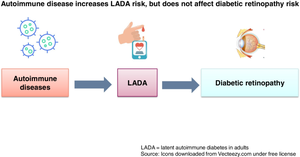Diabetologia ( IF 8.4 ) Pub Date : 2024-10-28 , DOI: 10.1007/s00125-024-06303-4 Cornelia Santoso, Yuxia Wei, Emma Ahlqvist, Tiinamaija Tuomi, Sofia Carlsson

|
Aims/hypothesis
The aim of this study was to clarify the impact of autoimmune disease (AD) comorbidity on the risk and prognosis of latent autoimmune diabetes in adults (LADA).
Methods
We used data from a Swedish study comprising newly diagnosed cases of LADA (n=586, stratified into LADAlow and LADAhigh by autoantibody levels), type 2 diabetes (n=2003) and matched control participants (n=2355). Information on 33 ADs and diabetic retinopathy was obtained by linkage to regional and national registers. We estimated the ORs for LADA and type 2 diabetes in relation to ADs before diabetes diagnosis, and the HRs for diabetic retinopathy after diabetes diagnosis. We performed functional pathway analyses to explore biological mechanisms driving the associations.
Results
Individuals with ADs exhibit an increased susceptibility to LADA (OR 1.70; 95% CI 1.36, 2.13), particularly those with thyroid dysfunction (OR 1.88; 95% CI 1.38, 2.56), inflammatory bowel disease (OR 1.78; 95% CI 1.00, 3.16) or vitiligo (OR 3.91; 95% CI 1.93, 7.94), with stronger associations being observed for the LADAhigh phenotype. Only psoriasis was linked to type 2 diabetes (OR 1.47; 95% CI 1.08, 1.99). The biological pathways shared by LADA and ADs revolved around immune responses, including innate and adaptive immune pathways. The HRs for diabetic retinopathy in LADA patients with and without AD vs those with type 2 diabetes were 2.11 (95% CI 1.34, 3.32) and 1.68 (95% CI 1.15, 2.45), respectively.
Conclusions/interpretation
We confirm that several common ADs confer an excess risk of LADA, especially LADA with higher GADA levels, but having such a comorbidity does not appear to affect the risk of diabetic retinopathy.
Graphical Abstract
中文翻译:

自身免疫性疾病与成人潜伏性自身免疫性糖尿病的风险和预后
目标/假设
本研究的目的是阐明自身免疫性疾病 (AD) 合并症对成人潜伏性自身免疫性糖尿病 (LADA) 风险和预后的影响。
方法
我们使用了来自瑞典一项研究的数据,包括新诊断的 LADA 病例 (n=586,按自身抗体水平分为 LADA低和 LADA高)、2 型糖尿病 (n=2003) 和匹配的对照参与者 (n=2355)。通过与地区和国家登记册的联系获得 33 例 AD 和糖尿病视网膜病变的信息。我们估计了糖尿病诊断前 LADA 和 2 型糖尿病与 AD 相关的 ORs,以及糖尿病诊断后糖尿病视网膜病变的 HRs。我们进行了功能途径分析,以探索驱动这些关联的生物学机制。
结果
AD 患者对 LADA (OR 1.70;95% CI 1.36, 2.13) 的易感性增加,尤其是甲状腺功能障碍 (OR 1.88;95% CI 1.38, 2.56)、炎症性肠病 (OR 1.78;95% CI 1.00, 3.16) 或白癜风 (OR 3.91;95% CI 1.93, 7.94) 的患者,观察到 LADA高表型的相关性更强。只有银屑病与 2 型糖尿病有关 (OR 1.47;95% CI 1.08, 1.99)。LADA 和 AD 共享的生物途径围绕免疫反应展开,包括先天性和适应性免疫途径。合并和不合并 AD 的 LADA 患者与 2 型糖尿病患者糖尿病视网膜病变的 HR 分别为 2.11 (95% CI 1.34, 3.32) 和 1.68 (95% CI 1.15, 2.45)。
结论/解释
我们确认几种常见的 AD 会带来 LADA 的额外风险,尤其是 GADA 水平较高的 LADA,但患有这种合并症似乎不会影响糖尿病视网膜病变的风险。


















































 京公网安备 11010802027423号
京公网安备 11010802027423号